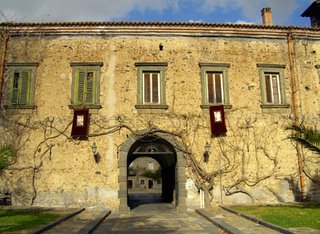Continuing my nostalgic journey through Sicily Scene's archives, I began to think about the many lovely places I have visited on this ever-fascinating island. I have no doubt about my favourite - it is the Valley of Temples in Agrigento and I especially enjoyed this visit. One of the most unusual events I have attended was the annual Easter display of "bread arches" at San Biagio Platani and I hope to get there again one day. Then there is the Infiorata in Noto [coming up soon], which I try to attend every year and of course I love Catania! These are but a few of the island's treasures and there is always something new, somewhere, to discover. But I think one of the most interesting trips I have taken was this early one, so I'll repeat the first of a series of posts on it here:
On the Nelson trail - 24th January 2007



About 37 miles northwest of Catania, tucked away in the shadow of Etna, lies the town of Bronte, the dukedom of which was bestowed upon a certain Admiral Horatio Nelson by a grateful King Ferdinando [III of Sicily and IV of Naples] in 1799. A little further on still is Maniace, where the former Benedictine Abbey became known as Il Castello dei Nelson. And that is where I have been today. It is a lovely and impressive place, as I hope the photos will show - much lovelier than I had anticipated. I should like to be able to tell you that England's saviour lingered there in the sun with his Emma - and many Sicilians believe that he did - but, alas, he died without ever having seen it. The first of his descendants to arrive there was his niece Charlotte, who, reaching it after a truly nightmarish journey, decided that it was not to her taste and stayed only three days! [More the fool her!] It was later used by other members of the family but under agrarian reform in Italy in 1961 much of the land was redistributed. The Nelson family sold the castle and park to the Comune of Bronte in 1981.
There may, however, be another British connection: the Rev. Patrick Prunty or Brunty, father of another Charlotte plus Emily, Anne and Branwell, changed his name to Brontë in 1802. I like to think that he did it as a homage to Nelson then added the diaeresis for effect and the dates do tally. By the way, I am not of the Mrs. Gaskell school of thought with regard to Patrick Brontë for I do not believe that he was a monster: he saw that his children were educated, encouraged them to write and cared for Branwell tenderly during the latter's last illness. I am also of the opinion that the main reason for his opposition to the Bell Nicholls marriage was concern for Charlotte's health, and in this he was, tragically, proved right. But I digress. Let us at least hope that poor, bereaved Mr. Brontë found some comfort in his name in the winter of his life. I wonder what, if anything, he knew of the little town in faraway, sunny Sicily? He was a well-read man, so it is possible that he knew something....
I now have to confess that I made this trip the lazy way. It would not be possible to get to Bronte and back in a day using public transport, so I hired a car and a driver. This is not a particularly cheap thing to do in Sicily but it was cheaper than staying in a Catania hotel overnight and, more importantly, saved me kennelling Simi for a night. ["And I should think so, too!" she is saying as she sits beside me, waiting for her walk.] This, again, is something the Sicilians need to sort out: no one will use Modica or anywhere else as a base if they can't get around. Not everyone wants to hire a car, as even if you are used to driving in Italy, to do so here is, at the very least, challenging! The best thing that towns of Modica's size could do to encourage tourism would be to organise escorted trips to places of interest such as Bronte.
But let us return to our hero. Nelson, me old hearty, I've always thought you looked terribly lonely all the way up there on that column. So next time I'm in London, I'll sit in the National Gallery's restaurant, gaze across at you and tell you all about your Duchy of Bronte today. How's that?
More photos - and more, and more - in a minute!
Here are links to the other posts about this visit:
On the Nelson trail - 2
On the Nelson trail - 3
On the Nelson trail - 4
On the Nelson trail - 5
On the Nelson trail - 6
On the Nelson trail - 7
I hope you enjoy them.
Here are links to the other posts about this visit:
On the Nelson trail - 2
On the Nelson trail - 3
On the Nelson trail - 4
On the Nelson trail - 5
On the Nelson trail - 6
On the Nelson trail - 7
I hope you enjoy them.






































































